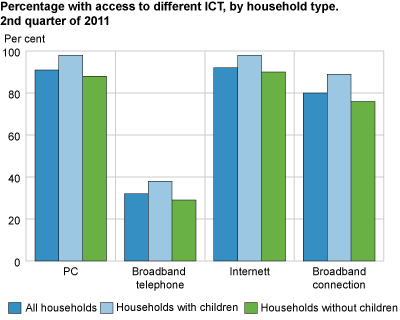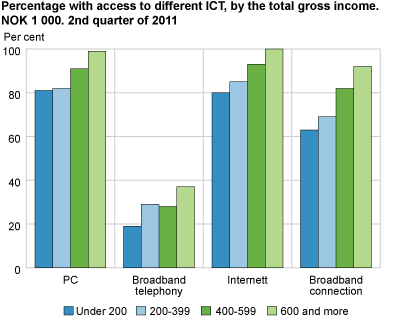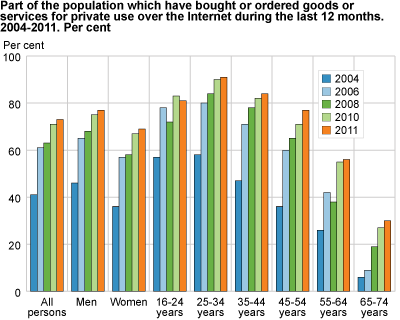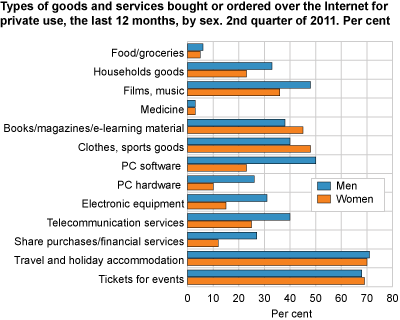Content
Published:
This is an archived release.
Three in five participate in social networks
Fifty-nine per cent of the population has participated in social networks in the 2nd quarter of 2011. Ninety-two per cent of households have access to the Internet. Access to mobile broadband is becoming more and more common, increasing from 22 to 34 per cent during the last year.
This community survey on ICT usage in households and by individuals shows for the first time figures of the percentage of the population that participates in social networks (e.g. Facebook, Twitter, etc.). About 3 in 5 people in Norway have participated in social networks over the Internet during the last three months. Social networks are generally more popular among the younger generation of the population. About 9 in 10 people under age 35 participated in social networks in the 2nd quarter of 2011. The corresponding figure for people aged between 65 and 74 was only 13 per cent.
Access to ICT
Generally, households with children and households with high incomes have access to information and communication technology (ICT) more often than others. All of the households with a gross income above NOK 600 000 have the Internet at home. The corresponding figure for households with an income below NOK 200 000 is still 80 per cent.
In total, 5 per cent of the Norwegian population has no access to the Internet as of the 2nd quarter of 2011. This group mainly consists of people aged over 64 years. One in 4 people aged between 65 and 74 have no access to the Internet. Meanwhile, the corresponding figure for people aged between 75 and 79 is 60 per cent.
The share of ADSL and other xDSL technologies in Norwegian homes has been reduced from 57 per cent in the 2nd quarter of 2010 to 48 per cent in the same quarter of 2011. Connections via fibre cable and cable TV, which provide much faster Internet solutions than DSL technologies, have increased respectively by 2 and 1 percentage points during the last year. Meanwhile, mobile broadband has increased rapidly in the last two years. In total, 34 per cent of households have access to mobile broadband in the 2nd quarter of 2011. One in 4 people have access to the Internet by mobile connection via a 3G handset. The percentage of households with only mobile broadband has also increased to 7 per cent.
Use of computers and the Internet
A total of 94 per cent of the population have used PCs during the last three months. The frequencies of PC-use between women and men are quite close. While almost everyone under 55 years has used a PC during the last three months, the corresponding figure for people aged between 65 and 74 years was only 67 per cent.
Eighty-two per cent of the population use the Internet every day or almost every day. Men use the Internet a little more often than women. Again, 1 in 3 people aged between 65 and 74 have no access to the Internet.
Activities over the Internet
Many people used the Internet to read online newspapers and to search information on, for example goods, services, travel, travel-related accommodation etc. in the last 3 months. Over half of the population has also utilised the Internet to seek health-related information (e.g. injury, disease, nutrition, improving health etc.).
The share of the population that has looked for information about education, training or course offers increased from 32 to 42 per cent. This percentage is especially high among the young generation aged between 16 and 24 years. However, only 7 per cent of the population has done an online course during the last three months. Consulting Wikipedia on the other hand is quite popular, with 7 in 10 people visiting Wikipedia to obtain knowledge in the 2nd quarter of 2011.
The share of the population that sold goods or services has increased from 14 to 24 per cent during the last year. Internet banking is also among the most important activities over the Internet, which is utilised by 85 per cent of the population as of the 2nd quarter of 2011.
Use of e-commerce
To buy or order goods or services for private use over the Internet is becoming increasingly popular. The total share of the population that has done e-commerce during the last 12 months has increased to 73 per cent. About 7 in 10 Internet traders have bought or ordered travel, holiday accommodation or tickets for events.
The percentage of men buying household goods, film, music, PC software and hardware, electronic equipment and telecommunication services is generally higher than the percentage of women; meanwhile women prefer to order books, magazines, clothes and sports goods over the Internet.
Use of e-Government
Seventy-six per cent of Internet-users have interacted with public authorities over the Internet in order to obtain information during the last 12 months. Over half of Internet users downloaded official forms and/or sent completed forms to public authorities. Two in 5 have also sent tax declarations in the last 12 months.
e-skills
The e-skill level among Norwegian people is quite high. Most of the population has carried out basic functions on the PC and Internet. The figures also indicate that men on average have a slightly higher level of proficiency in IT than women. In addition, the younger generations are normally better at PC and Internet use than the older generations. A population with higher education has statistically better computer skills than a population with lower education. However, this difference is not so apparent with regard to Internet skills.
|
Many other European countries produce statistics on ICT usage in households in cooperation with the EU’s statistics office Eurostat. The plan for this survey is adapted to Eurostat guidelines. Internationally comparable figures can be found here: http://epp.eurostat.ec.europa.eu/portal/page/portal/information_society/introduction . |
|
For more information about the survey, please refer to About the statistics . |
Tables:
- Table 1 Percentage with access to different ICT, by household type and household income. 2nd quarter of 2011
- Table 2 Percentage with different kinds of Internet subscriptions, by household type, household income, sex, age, education and employment situation. 2nd quarter of 2011
- Table 3 Use of computers the last 3 months, by sex, age, education and employment situation. 2nd quarter of 2011. Per cent
- Table 4 Use of the Internet, frequency and location of use last 3 months. Percentage of population, by sex, age, education and employment situation. 2nd quarter 2011
- Table 5 Purpose and nature of activities on the Internet the last 3 months. Percentage of population, by sex, age, education and employment situation. 2nd quarter of 2011
- Table 6 Purpose and nature of activities on the Internet the last 3 months. Percentage of population, by sex, age, education and employment situation. 2nd quarter of 2011
- Table 7 Percentage of Internet users using e-Government, by sex, age, education and employment situation. 2nd quarter of 2011
- Table 8 Types of goods and services bought or ordered over the Internet for private use, the last 12 months, by sex, age, education and employment situation. 2nd quarter of 2011. Per cent
- Table 9 Types of goods and services bought or ordered over the Internet for private use, the last 12 months, by sex, age, education and employment situation. 2nd quarter of 2011. Per cent
- Table 10 E-skills. PC related aktivites carried out. Percentage of population, by sex, age, education and employment situation. 2nd quarter of 2011
- Table 11 E-skills. Internet related aktivites carried out. Percentage of population, by sex, age, education and employment situation. 2nd quarter of 2011
Contact
-
Bruk av IKT i husholdningene
E-mail: ikthus@ssb.no




